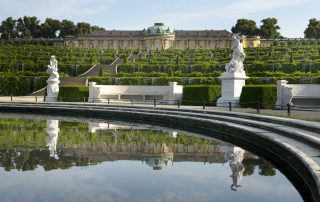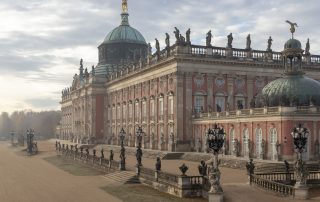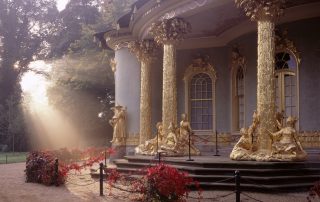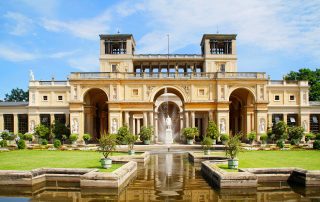
Palaces and parks of Potsdam and Berlin
In 1990, UNESCO inscribed the Potsdam-Berlin park landscape – stretching from Sanssouci, the New Garden and Sacrow in Potsdam to Berlin’s Peacock Island and Glienicke – on the list of Natural and Cultural Heritage of Humanity. The World Cultural site “Palaces and Parks of Potsdam and Berlin” is a world-renowned cultural landscape and an inspiration for art, architecture and landscape design enthusiasts from around the globe. The extraordinary ensemble’s almost paradisiacal beauty lent it the epithet “the Prussian Acadia.”
Over the centuries, leading architects and landscape designers have creatively adapted various building styles to form a distinctive Gesamstkunstwerk that delights with its accomplished interplay of structural and landscape architecture. Today’s World Heritage site dates back to 1745, when Frederick the Great commissioned Sanssouci Palace to be built as his summer residence. That makes Sanssouci the oldest feature of the palaces and parks of Potsdam and Berlin.
The German Democratic Republic had requested on September 29, 1989 that the Potsdam Palaces and Parks be inscribed in the UNESCO World Heritage List. The Federal Republic of Germany subsequently proposed on June 14, 1990 that the landscape along the Havel River encompassing the palace and park in Glienicke and Peacock Island also be designated a World Heritage site.
On December 12, 1990, just two months after the reunification of the two German constituent states, the UNESCO World Heritage committee resolved to inscribe the “Palaces and Parks of Potsdam and Berlin” in the World Heritage List. Gemany’s reunification and the UNESCO commendation made it possible to rejoin and reconstruct the cultural landscape so brutally bisected during the Cold War by border installations and fortifications.
The Berlin-Brandenburg parks comprising Sacrow, Babelsberg and the New Garden had been disfigured beyond recognition with a 3.60 meter (approx. 12 ft) high wall, military tracks, watch towers and fences. In the 1990s, the Stiftung Preußische Schlösser und Gärten Berlin-Brandenburg (SPSG) began restoration of the walkways and open areas. The Potsdam-Berlin cultural landscape presents itself once again as a scene of impressive harmony and coherence. With a total area of 2064 hectares (approx. 5100 acres), it is one of the largest UNESCO World Heritage sites in Germany.
Since October 30, 2019, Potsdam has also been part of the worldwide network of the UNESCO Creative Cities. This has set itself the goal of profitably sharing the creative skills of the member cities within the framework of the exchange of knowledge and cooperative, sustainable development in social, cultural and ecological issues. In the course of this, Potsdam was honored as the sole Creative City of Film in Germany due to its world-famous and historically significant Babelsberg film studios and its characteristic as a recurring setting for internationally produced feature films and TV productions.
Palaces and Parks of Potsdam and Berlin
UNESCO World Heritage since 1990
From the selection criteria
The ensemble is an outstanding example of architectural creations and landscaping against the spiritual background of the monarchist state idea.
The entire complex of the parks of Potsdam is a cultural asset of exceptional quality.
Information und Kontakt
Potsdam Marketing und Service GmbH
Humboldtstraße 1-2
14467 Potsdam
Tel.+49 331-27 55 88 99
Stiftung Preußische Schlösser und Gärten
Berlin-Brandenburg
Tel. +49 331-96 94 200





